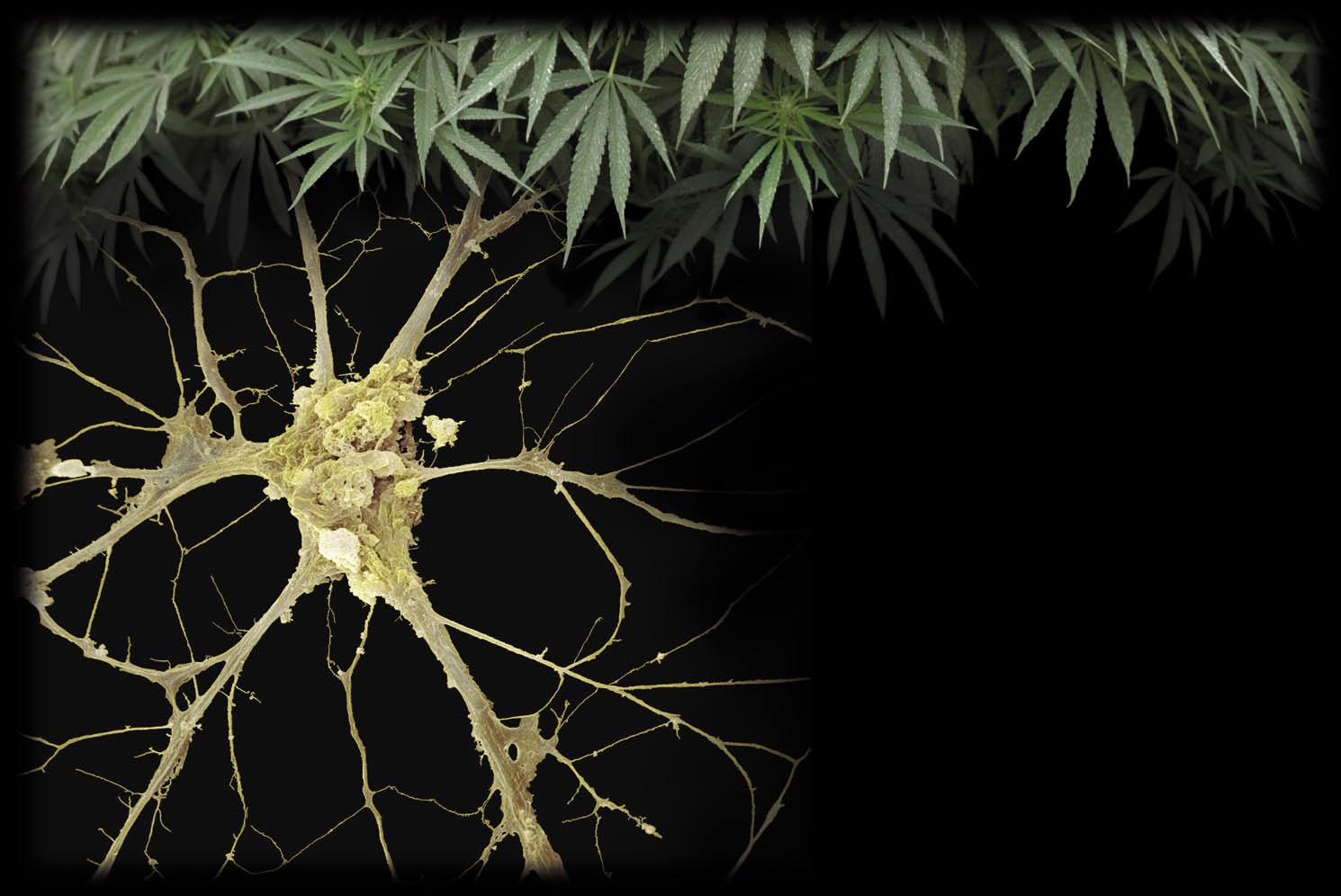Natural high

COPYRIGHT 2006 SCIENTIFIC AMERICAN, INC.
COPYRIGHT 2006 SCIENTIFIC AMERICAN, INC.




The brain produces its own "marijuana" to
protect neurons, and researchers hope to
exploit it to ease anxiety, obesity and addiction
COPYRIGHT 2006 SCIENTIFIC AMERICAN, INC.



hemically speaking, we are all potheads.
ling appetite, and in the cerebellum, which gov-
Raphael Mechoulam of Hebrew Uni-
erns muscle coordination. They are also preva-
versity in Jerusalem discovered that
lent in the hippocampus, important to memory
astounding fact in 1992, and now the
formation, as well as in the amygdala, involved
Creasons why are fi nally emerging. Nu-in emotion and anxiety. And they are found in
merous experiments with genetically
the neocortex, the site of such cognitive functions
altered mice and rats have shown that
as speech and integration of the senses. Given the
when natural brain compounds, called
endocannabinoids' roles, it is easy to understand
endocannabinoids, are missing or their re-
the classic signs of a pot smoker who is high:
ceptors are blocked, the animals are more sus-
calm demeanor, poor motor coordination, al-
ceptible to pain, cannot control their appetites,
tered sensory perceptions and an eventual attack
have trouble handling anxiety and are less able
of the munchies.
to cope with stress.
What surprised investigators, when it became
By fully understanding and then harnessing
clear that the endocannabinoids were communi-
the endocannabinoid mechanisms, researchers
cating between neurons, was that the direction
are eager to devise new ways to reduce pain, calm
of communication occurred in reverse. When a
anxiety, fi ght obesity, stop nicotine addiction
typical neuron fi res, it releases neurotransmitters
and even treat traumatic shock and Parkinson's
that are stored near the tip of its axon. The sig-
disease—without the unwanted side effects of
naling chemicals cross a small gap, or synapse,
smoking marijuana.
and dock with receptors on the dendrite of the next neuron, causing it to fi re, and so on down
Signals in Reverse
the chain. The endocannabinoids, however, are
To be precise, endocannabinoids do not mim-
rapidly synthesized in the recipient neuron's cell
ic the effects of marijuana. It is the drug, derived
membrane. They cross the gap in reverse, dock-
from the hemp plant, that approximates the brain's
ing at the axon [see box on page 64]. Neurosci-
endocannabinoid chemistry. A decade of study
entists had thought this retrograde signaling oc-
has shown that a specifi c receptor on certain neu-
curred only during fetal development of the ner-
rons—the cannabinoid receptor 1, or CB1—binds
vous system.
to delta-9-tetrahydrocannabinol (THC), the ac-
Using mice and rats in labs, researchers slow-
tive ingredient in cannabis, the dried leaf of mari-
ly fi gured out the reason for the retrograde com-
juana. The same receptor binds to a class of fatty
munication. "A neuron that has just received a
The human brain's cannabinoid system seems
to fulfi ll multiple functions.
acids produced by neurons—the endocannabi-
message can send one right back that says, ‘Stop
noids. Mechoulam named the one he discovered
transmitting!'" explains Andreas Zimmer, a
anandamide—after ananda, the Sanskrit word for
neurobiologist at the University of Bonn in Ger-
"bliss." Subsequently, Daniele Piomelli and Nephi
many who helped defi ne the backward mecha-
Stella of the University of California, Irvine, found
nism. "The endocannabinoids are an inhibitory
a second compound, called 2-AG, with similar
feedback loop. The second neuron reports back
characteristics. THC happens to resemble these
to the sender: ‘Message received. Cease fi ring. I
substances closely enough that the CB1 receptors
e ) (pisb
latch onto it, unleashing similar or magnifi ed ef-
. (nc ann
fects on the toker's brain.
CB1 receptors are not everywhere in the
According to Ibn Al Badri, an Arab chronicler,
eh is (c
brain—they exist in concentrated pockets in
people knew about the inhibitory effects of hash-
es C
many varied locations. The distribution suggests
ish, also derived from hemp, at the court of the
that the human cannabinoid system fulfi lls mul-
caliphs in 15th-century Baghdad. For one thing,
tiple functions [see box on opposite page]. For
hashish reportedly stopped the epileptic seizures in
example, numerous receptors exist in the hypo-
the son of a high offi cial. Such attacks arise when
thalamus, which plays a central role in control-
neurons fi re in rampant unison across the brain—
62 SCIENTIFIC AMERICAN MIND
August /September 2006
COPYRIGHT 2006 SCIENTIFIC AMERICAN, INC.
Crucial Roles Endocannabinoid receptors are concentrated in many classic behaviors associated with smoking marijuana and
brain regions, making them crucial to various func-
the potential payoff of drugs that mimic endocannabinoid
tions. Their distribution also explains some of the effects for patients with severe pain or other problems.
Controls appetite,
hormone levels and
Site of higher cognitive
the integration of
sensory information
Involved in motor
Crucial to memory and
the learning of facts
anxiety, fear and emotion
Brain Stem and Spinal Cord
Seat of motor control
Central to the vomiting reflex and the
sensation of pain
meaning no inhibition signal stops them. Today
at the University of Texas at San Antonio, has
some epileptics can somewhat manage their at-
confirmed this theory working with Parkinson's
tacks by smoking cannabis regularly. And yet for
patients. In Parkinson's disease, neurons in cer-
others, seizures worsen after this self-therapy.
tain brain regions that produce the neurotrans-mitter dopamine die off. As a result, victims de-
velop severe motor problems. A certain toxin
Still, experts now for the most part agree that
that kills dopamine-producing neurons causes
the main function of the endocannabinoids is to
similar symptoms. So Giuffrida injected the tox-
protect neurons from excessive activity. The
in into lab mice a few minutes after giving them
brain "has created a kind of emergency brake for
a synthetic cannabinoid. The cannabinoid pre-
use when needed," says Beat Lutz, a physiologi-
vented the toxin's destructive effects. "The brains
cal chemist at the University of Mainz in Germany
of the mice that had been treated with the mari-
who has also helped elucidate endocannabinoid
juanalike substance could scarcely be distin-
mechanisms. If a neuronal storm threatens, the
guished from those of normal mice," Giuffrida
endocannabinoids are released to block it. Ac-
says. He hopes that his work will ultimately lead
cording to Lutz, this protective mechanism plays
to compounds that stop the destruction of dopa-
an important role well beyond epilepsy. "It ap-
pears to be quite general," the researcher ex-
plains. "If the brain has a problem, it produces
ULRICH KRAFT, a freelance science writer in Berlin, wrote the cover story
Andrea Giuffrida, a pharmacology professor
on burnout in the June/July issue of Scientific American Mind.
w w w. sciammind.com
SCIENTIFIC AMERICAN MIND 63
COPYRIGHT 2006 SCIENTIFIC AMERICAN, INC.
Retrograde Communication A t a typical synapse, the knob at the end of a neuron postsynaptic cell's membrane, then exit and dock at the
secretes neurotransmitters such as glutamate knob's CB1 receptors. When docking occurs, that tells (green). These neurotransmitters diffuse across the presynaptic cell to stop releasing glutamate. The
the gap to receptors on a neighboring neuron. The endo-
endocannabinoids, acting as neuromodulators, may
cannabinoids work in reverse. They are produced in the protect neurons from overarousal.
Signal direction for
Signal direction for
mine-producing neurons, helping to fight Parkin-
ger a threat, gradually extinguishing the fear.
son's in its early stages.
Rodents with missing or blocked CB1 receptors,
Zimmer concurs that the endocannabinoids'
however, do not lose their fear. The endocan-
primary purpose is to help protect the mental
nabinoids, it seems, are crucial to diminishing
organism from stress. He says, "They protect
bad feelings, and a faulty system might be a prime
nerve cells not just from overarousal, but also, for
contributor to post-traumatic stress syndrome or
example, from the harmful effects of stress hor-
mones such as cortisol." Lutz adds that cannabi-
t ise
noids also "put the body into recovery mode";
muscles slacken, pulse and blood pressure go
That a whole lot of things happen when you
down, and mental activity is lessened
flood your brain with THC is old news for
e G
marijuana smokers, but the effects have sudden-
Experts are starting to explain various psy-
ly piqued the interest of the pharmaceutical
chological effects as well. They have trained ro-
dents to fear certain stimuli, then retrained them
The pharmaceutical company Sanofi-Aven-
to subsequently learn that the stimuli are no lon-
tis, based in Paris, has developed a new drug
64 SCIENTIFIC AMERICAN MIND
August /September 2006
COPYRIGHT 2006 SCIENTIFIC AMERICAN, INC.
called Acomplia, which is already in trials. Its
Second, possible side effects related to sus-
active ingredient, rimonabant, blocks CB1 recep-
tained alteration of the CB1 receptors are un-
tors and is thus supposed to help overweight
known and cannot be ruled out. "We have al-
people shed pounds. "Cannabinoids arouse one's
most no idea what will happen if we inhibit the
appetite, apparently through the reward system,"
endogenous cannabinoid system over the long
Zimmer explains. Because rimonabant binds to
term," Zimmer says of the brain's natural reward
the sites normally used by endocannabinoids, it
mechanisms. His perspective comes from his lat-
may be able to stop cravings for food. The prin-
est experiments with genetically altered mice.
ciple seems to work, according to results of a
When they were young, the mice did markedly
company study of 3,000 U.S. and Canadian vol-
better than their unaltered peers in various learn-
unteers, which Sanofi-Aventis released in Febru-
ing tests. But at the age of three to five months—
ary. Participants who took the CB1 blocker each
the prime of life—the mice without CB1 recep-
day lost more weight than a control group given
tors were learning almost as poorly as normal
a placebo. In addition, markers in standard blood
mice at 18 months old, which is elderly. Studies
No one anticipated what has proved to be an
entirely new communication system in the brain.
tests that indicate a high risk of stroke or heart
of the pothead mice revealed they had suffered
attack were lower.
damage to the hippocampus, the central switch-
How much of the advantage comes from af-
board for storing memories. The mice that pos-
fecting signals among neurons is not clear, how-
sessed no receptors for their endogenous canna-
ever, in Lutz's opinion. He ascribes the positive
binoids lost significantly more neurons in the
metabolic effects at least partially to the drug's ef-
hippocampus than the regular mice did.
fect on peripheral organs, which harbor CB1 recep-
This premature cell death, Zimmer believes,
tors, too. "In the obese, the endocannabinoid sys-
could be caused by the loss of the neuroprotective
tem is overactive in the liver," he says. "Rimonabant
effects of the endocannabinoids. "We must move
seems to restore it to equilibrium."
very carefully to make sure that deliberate medi-
Of course, eating is not the only activity that
cal inhibition of the CB1 receptors does not lead
triggers the brain's reward system. Many addic-
to such damage," he says, adding that appropri-
tive substances do so as well; nicotine prompts
ate long-term trials must be held before drugs are
the secretion of more dopamine, providing users
released for clinical use in human patients. The
with satisfied, euphoric feelings. Blocking the en-
pharmaceutical industry may have a different
docannabinoid receptors could negate the in-
point of view, however; companies such as Sano-
creased secretion of dopamine, reducing the
fi-Aventis hope to bring products to the market
pleasant feelings that make smokers reach for an-
other cigarette.
Drug sales aside, the unraveling of the endo-
cannabinoid system is exciting neuroscientists.
Long-Term Concerns
No one anticipated what has proved to be an en-
Despite some possible benefits, experts are
tirely new communication system in the brain.
still wary about tinkering with our natural mar-
Further research will outline the complete mech-
ijuana network. "The brain is a sensitive system
anisms and could provide novel treatments for a
based on inhibitory and excitatory influences,
wide range of psychiatric conditions and brain
and the endocannabinoids keep this system in
balance," Lutz notes.
One fundamental complication is that, like
(Further Reading)
marijuana itself, man-made versions of endocan-nabinoids do not simply travel only to desired
◆ Endocannabinoid Signaling in the Brain. R. I. Wilson and R. A. Nicoll in
sites. They spread throughout the brain when
Science, Vol. 296, pages 678–682; April 26, 2002.
taken, causing multiple effects, including dizzi-
◆ Early Age-Related Cognitive Impairment in Mice Lacking Cannabinoid
CB1 Receptors. A. Bilkei-Gorzo et al. in Proceedings of the National
ness, drowsiness, and concentration and think-
Academy of Sciences USA, Vol. 102, No. 43, pages 15670–15675;
ing problems.
October 25, 2005.
w w w. sciammind.com
SCIENTIFIC AMERICAN MIND 65
COPYRIGHT 2006 SCIENTIFIC AMERICAN, INC.
Source: http://jb-schnittstelle.de/wp-content/uploads/2014/08/Natural-high1.pdf
Current cv
CURRICULUM VITAE TERRI ELIZABETH WEAVER, PH.D., RN, FAAN BUSINESS ADDRESS HOME ADDRESS University of Illinois at Chicago - College of Nursing 814 Franklin Avenue River Forest, IL 60305 Chicago, IL 60612-7350 708/771/5623 (home) 312/919/5978 (cell) 610-293-4598 (fax) [email protected] 312/413/4399 (fax)
Chemwatch msds print
Thinner #12 Hazard Alert Code: HIGH Altex Coatings Limited GHS Safety Data Sheet (REVIEW)Issue Date: 31-May-2012 ALTEX COATINGS LIMITED 9-36064 Version No:1 Page 1 of 12 Section 1 - CHEMICAL PRODUCT AND COMPANY IDENTIFICATION PRODUCT NAMEThinner #12 PROPER SHIPPING NAME9-36064PAINT RELATED MATERIAL